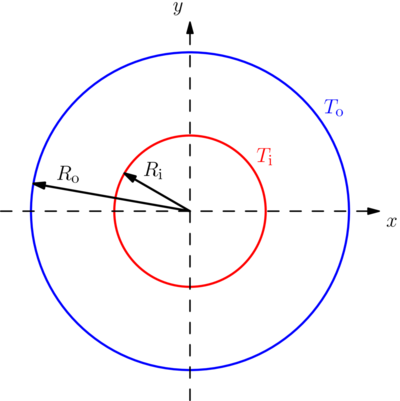Difference between revisions of "Natural convection between concentric cylinders"
(→Introduction) |
(→Introduction) |
||
| Line 11: | Line 11: | ||
</figure> | </figure> | ||
| − | The equations to be solved | + | To solve this problem we will use the same formulation as Kuehn and Goldstein (1975) only that we will use MLSM to supply the discrete approximations to the PDE operators. Note that in the actual computations it is convenient to use the velocities rather than the derivatives of the stream function in the coefficients. The equations to be solved may then be written as |
\begin{equation} | \begin{equation} | ||
\Delta \psi = \omega | \Delta \psi = \omega | ||
| Line 17: | Line 17: | ||
\begin{equation} | \begin{equation} | ||
\frac{\partial \omega}{\partial t} + u\frac{\partial \omega}{\partial x} + v\frac{\partial \omega}{\partial y} = \nu \Delta \omega + \left(\frac{\partial g_x}{\partial y} - \frac{\partial g_y}{\partial x}\right) | \frac{\partial \omega}{\partial t} + u\frac{\partial \omega}{\partial x} + v\frac{\partial \omega}{\partial y} = \nu \Delta \omega + \left(\frac{\partial g_x}{\partial y} - \frac{\partial g_y}{\partial x}\right) | ||
| + | \end{equation} | ||
| + | \begin{equation} | ||
| + | \rho c_\mathrm{p}\frac{\partial T}{\partial t} + (\b{v}\cdot\nabla)T = k \Delta T | ||
\end{equation} | \end{equation} | ||
=Sources= | =Sources= | ||
Kuehn, T. H., and R. J. Goldstein. "An experimental and theoretical study of natural convection in the annulus between horizontal concentric cylinders." Journal of Fluid mechanics 74, no. 4 (1976): 695-719. | Kuehn, T. H., and R. J. Goldstein. "An experimental and theoretical study of natural convection in the annulus between horizontal concentric cylinders." Journal of Fluid mechanics 74, no. 4 (1976): 695-719. | ||
Revision as of 03:00, 11 December 2017
Click here to return back to Fluid Mechanics
Introduction
Another classical fluid flow benchmark is that of natural convection heat transfer in the annular space between concentric cylinders. This problem was first studied numerically by Kuehn and Goldstein (1975) using a stream function-vorticity formulation of the Navier-Stokes equations. Several assumptions are made in specifying the problem. First of all the flow is assumed to be invariant along the axis of the cylinders which leads to a two-dimensional flow configuration as schematically shown in the figure below. A constant property Boussinesq approximation is used. The buoyancy force may then be given as: \[ \b{g} = \left(\begin{matrix}g_x \\ g_y \end{matrix}\right) = \left(\begin{matrix}0 \\ g \beta \left(T - T_\mathrm{o}\right) \end{matrix}\right) \] where $g$ is the gravitational acceleration, $T$ the temperature at a point within the fluid, $T_\mathrm{o}$ the temperature of the outer cylinder and $\beta$ the thermal volumetric expansion coefficient. The inner cylinder is held at a constant temperature $T_\mathrm{i}$.
To solve this problem we will use the same formulation as Kuehn and Goldstein (1975) only that we will use MLSM to supply the discrete approximations to the PDE operators. Note that in the actual computations it is convenient to use the velocities rather than the derivatives of the stream function in the coefficients. The equations to be solved may then be written as \begin{equation} \Delta \psi = \omega \end{equation} \begin{equation} \frac{\partial \omega}{\partial t} + u\frac{\partial \omega}{\partial x} + v\frac{\partial \omega}{\partial y} = \nu \Delta \omega + \left(\frac{\partial g_x}{\partial y} - \frac{\partial g_y}{\partial x}\right) \end{equation} \begin{equation} \rho c_\mathrm{p}\frac{\partial T}{\partial t} + (\b{v}\cdot\nabla)T = k \Delta T \end{equation}
Sources
Kuehn, T. H., and R. J. Goldstein. "An experimental and theoretical study of natural convection in the annulus between horizontal concentric cylinders." Journal of Fluid mechanics 74, no. 4 (1976): 695-719.
